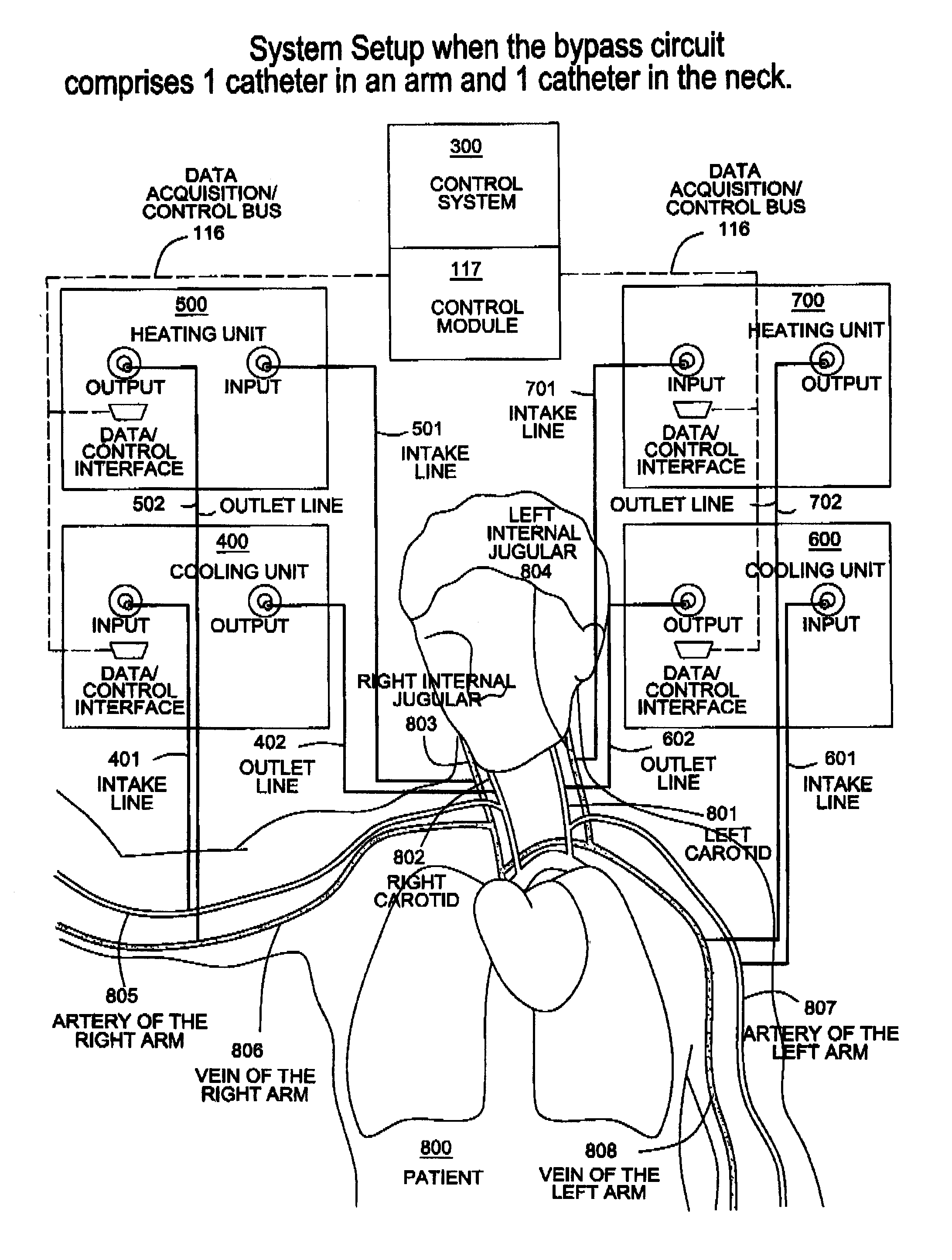Apparatus, system and methods for extracorporeal blood processing for selectively cooling the brain relative to the body during hyperthermic treatment or to induce hypothermia of the brain
a technology of extracorporeal blood and brain, applied in the field of induced hyperthermia or hypothermia, can solve the problems of human brain damage, difficult to ensure that the entire tumour is being exposed to sufficient temperatures, and potentially detrimental effects, so as to prolong the treatment duration, prolong the treatment time, and reduce the effect of adverse effects
- Summary
- Abstract
- Description
- Claims
- Application Information
AI Technical Summary
Benefits of technology
Problems solved by technology
Method used
Image
Examples
experiment b
[0239]
[0240]This experiment is identical to the previous experiment, with one major difference. Here we wanted to keep the cerebral temperature constant. As such, the setpoint temperature of the Carotid Arterial Blood Cooling unit was allowed to vary. The setpoint temperature of the cooling unit was controlled in a loop and was based on the temperature of the venous blood returning from the brain. Our objective was to keep the average cerebral temperature constant at 37.6° C., which corresponds to roughly a venous blood temperature returning from the brain of 37.3° C. A control loop was implemented where if the temperature of the venous blood returning from the brain flowing down the internal jugular was greater than 37.3° C. (prior to passing through the Heating Unit), then temperature of the setpoint temperature of the Carotid Arterial Blood Cooling Unit was decreased by 0.02° C. The update rate was every 2 minutes. Conversely, if the venous blood temperature was below 37.3° C., t...
experiment c
[0244]
[0245]This procedure is designed to expose the patient to two temperature plateaus. The first plateau will be at 44° C. for a period of 4 hours, after which the patients core body temperature will be allowed to drop to 42° C., where it will be maintained until a total of 12 hours have elapsed. The purpose of this profile is to leverage the Step Down phenomena which has been observed clinically during whole body hyperthermia trials, where the cells of cancerous tissue is sensitized to heat by being previously exposed to an elevated temperature.
[0246]Further, an Infra Red Heating system which generates long wavelength IR radiation has been added to the setup. Long wavelength infra red has been found to be well suited for the induction of hyperthermia since this frequency of light penetrates deep into the skins and the heat flux is distributed across a fairly thick layer of tissue, which helps prevent burns. The IR lamps are capable of inducing up to 1000 W of heat to the patient...
experiment d
[0267]
[0268]This experiment is identical to Experiment C with one key exception. Over the coarse of the procedure we decrease the Cerebral temperature by 1° C. During the initial hour the Cerebral temperature is decreased from the initial value of 37.6° C., down to 36.6° C. and it is maintained at this value for the full 12 hour duration. After the 12 hour period, the cerebral temperature is gradually increased back to its normal value of 37.6° C. The cerebral temperature is modified by controlling the temperature of the arterial blood flowing up the internal carotid. The cerebral temperature is monitored like before, by measuring the blood temperature returning from the brain in the internal jugular vein. In this particular experiment, the arterial blood is cooled to a temperature as low as 35.1° C. to achieve the desired cerebral temperature of 36.6° C. It is assume that 10% of the cerebral blood supply is coming form the vertebral arteries, and enters the brain at the core body t...
PUM
 Login to View More
Login to View More Abstract
Description
Claims
Application Information
 Login to View More
Login to View More - R&D
- Intellectual Property
- Life Sciences
- Materials
- Tech Scout
- Unparalleled Data Quality
- Higher Quality Content
- 60% Fewer Hallucinations
Browse by: Latest US Patents, China's latest patents, Technical Efficacy Thesaurus, Application Domain, Technology Topic, Popular Technical Reports.
© 2025 PatSnap. All rights reserved.Legal|Privacy policy|Modern Slavery Act Transparency Statement|Sitemap|About US| Contact US: help@patsnap.com



